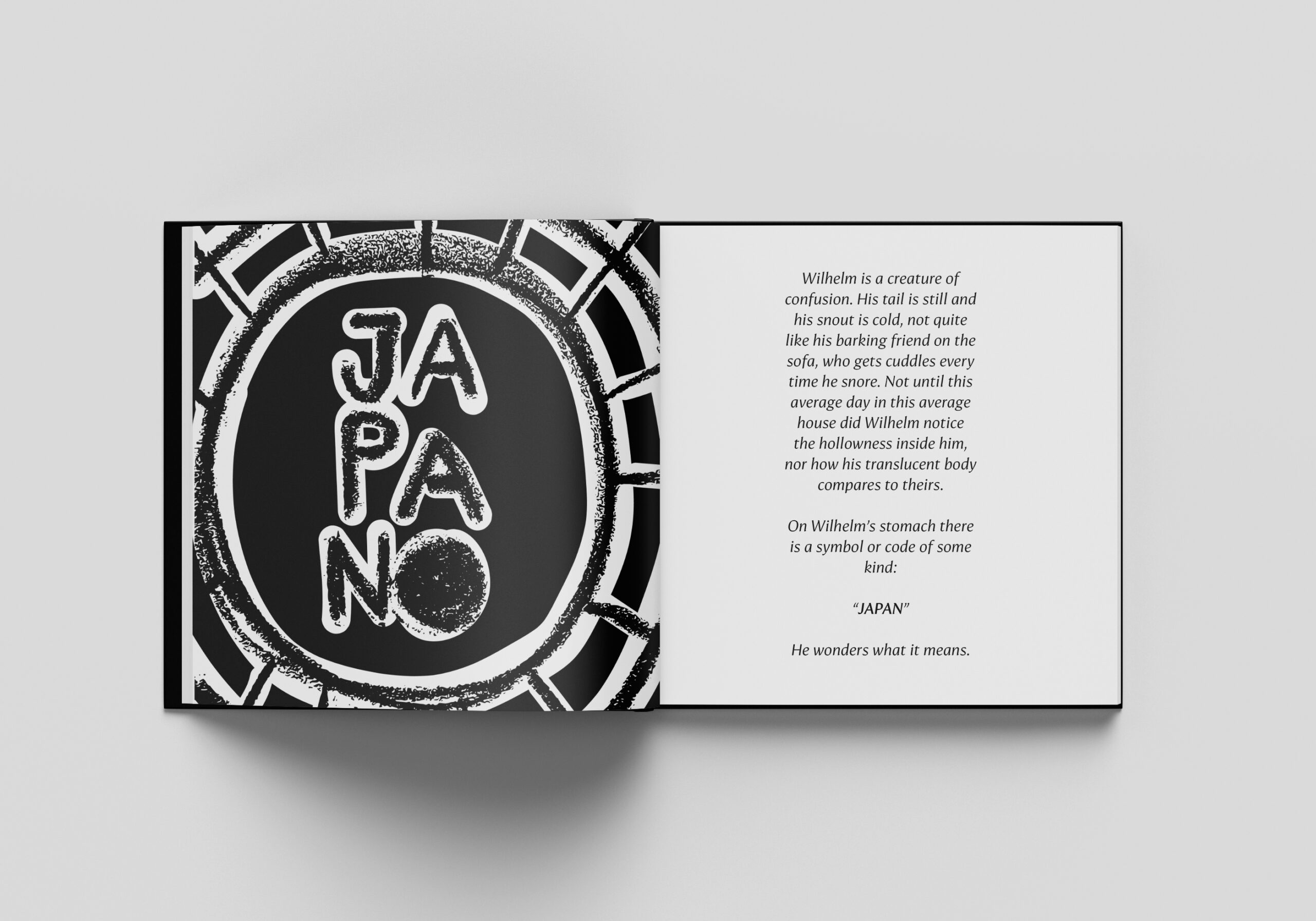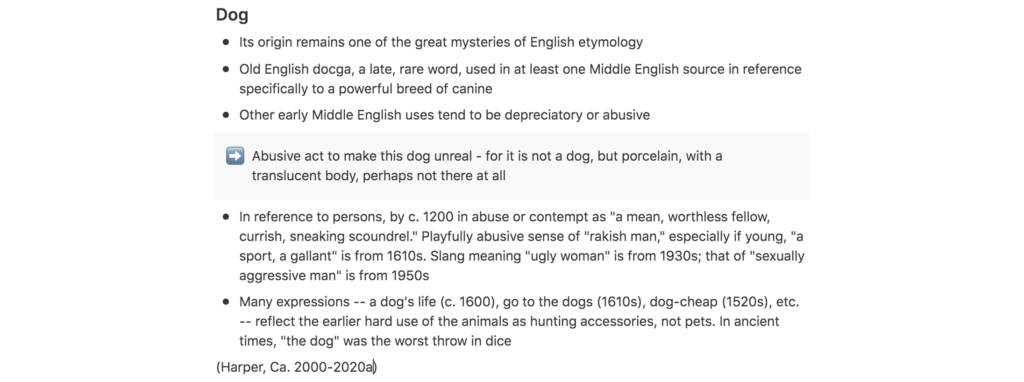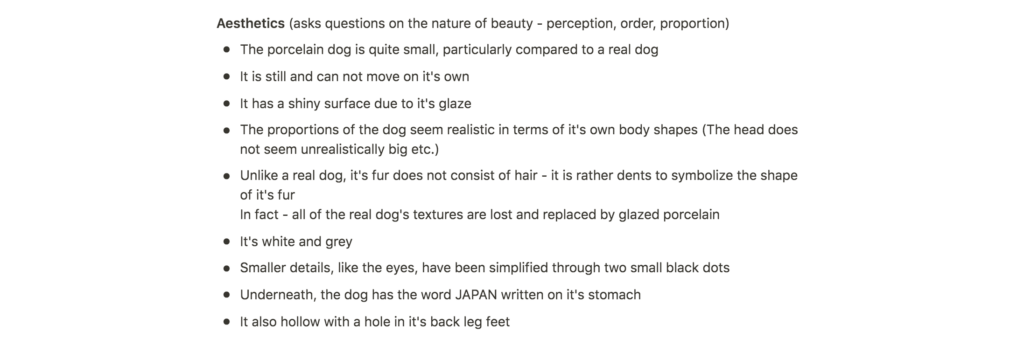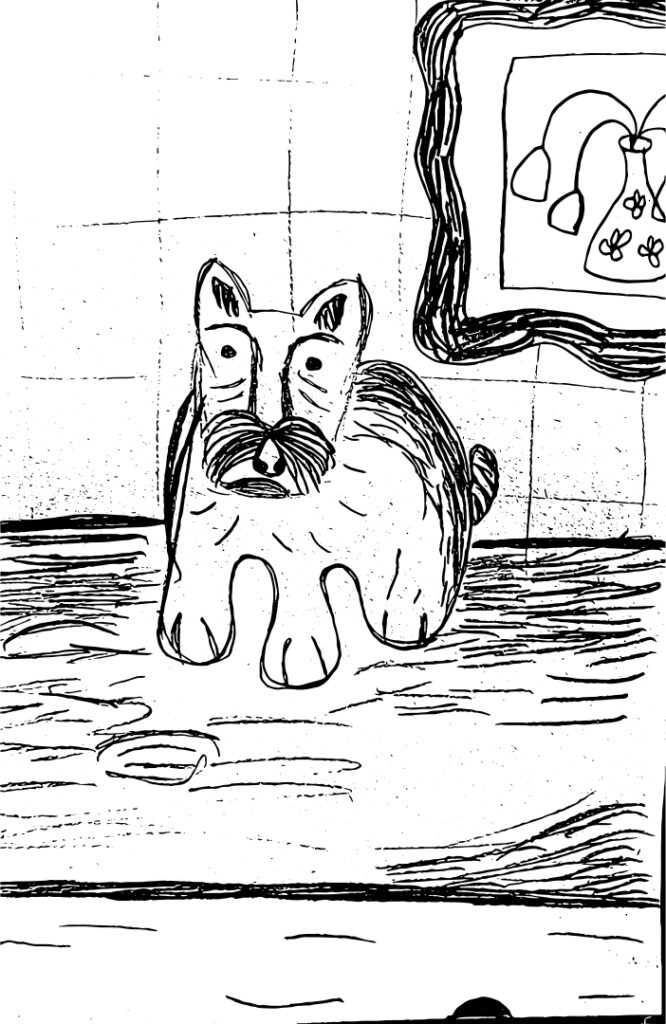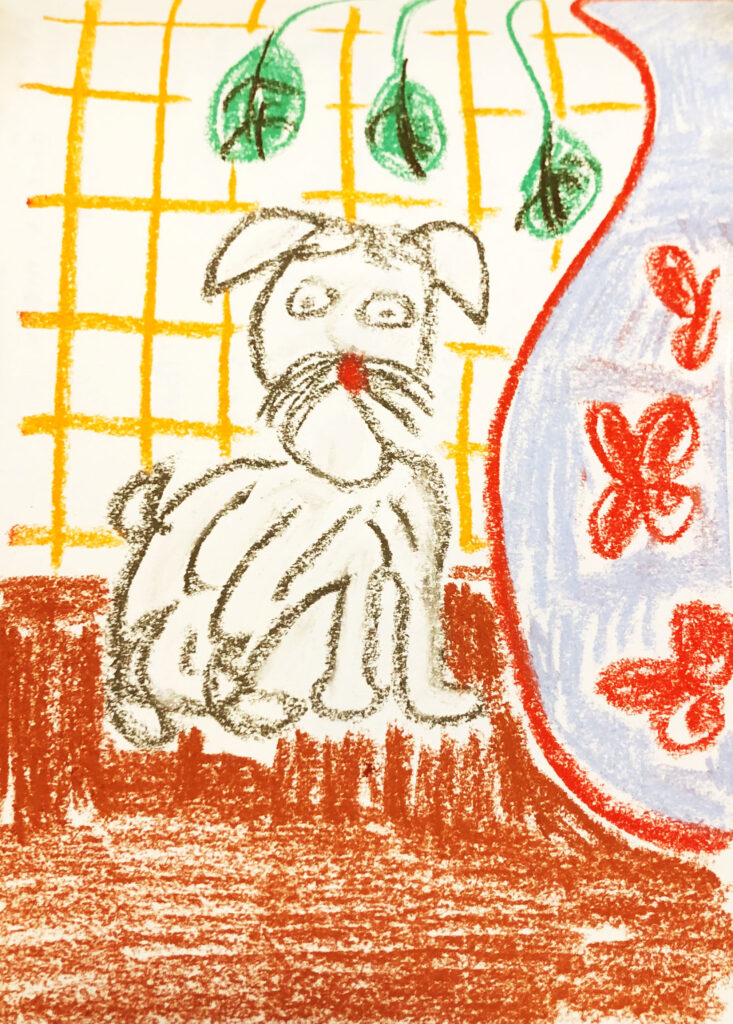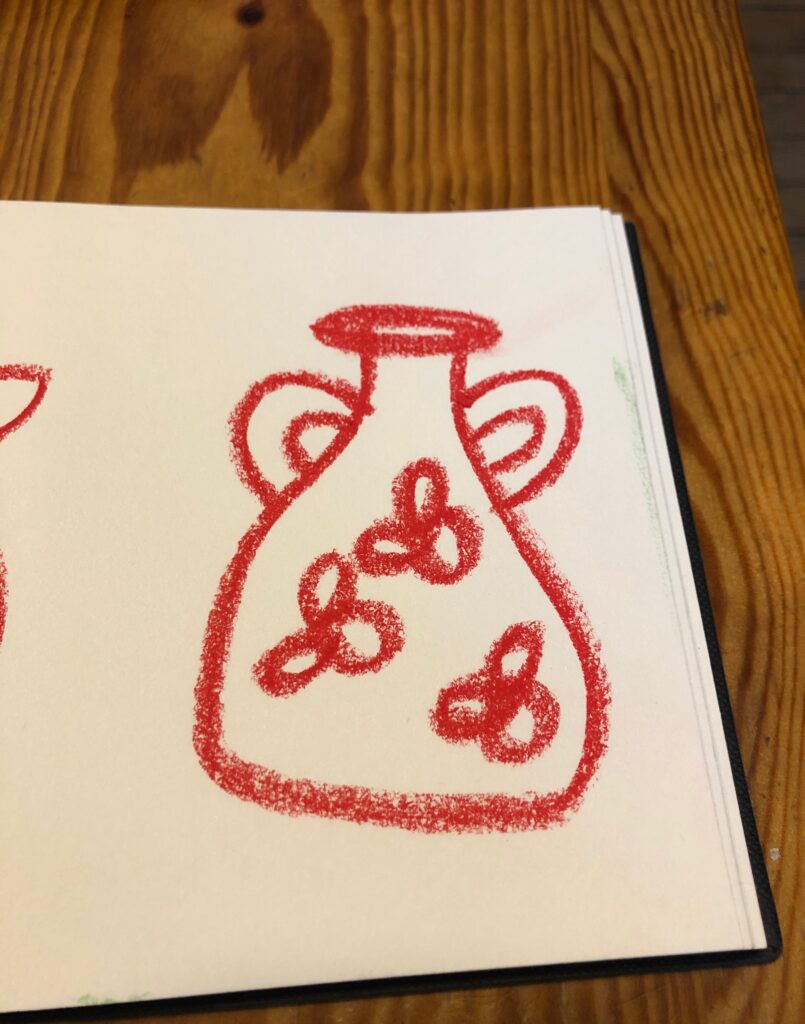Lecture notes
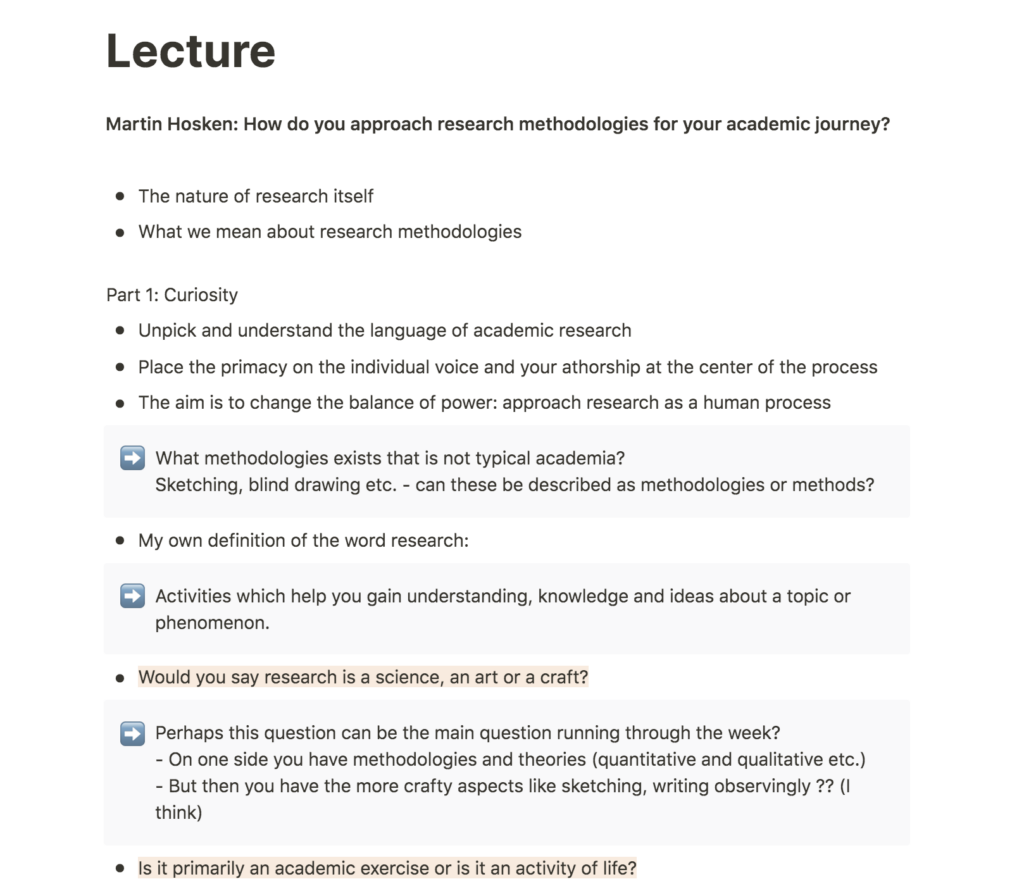
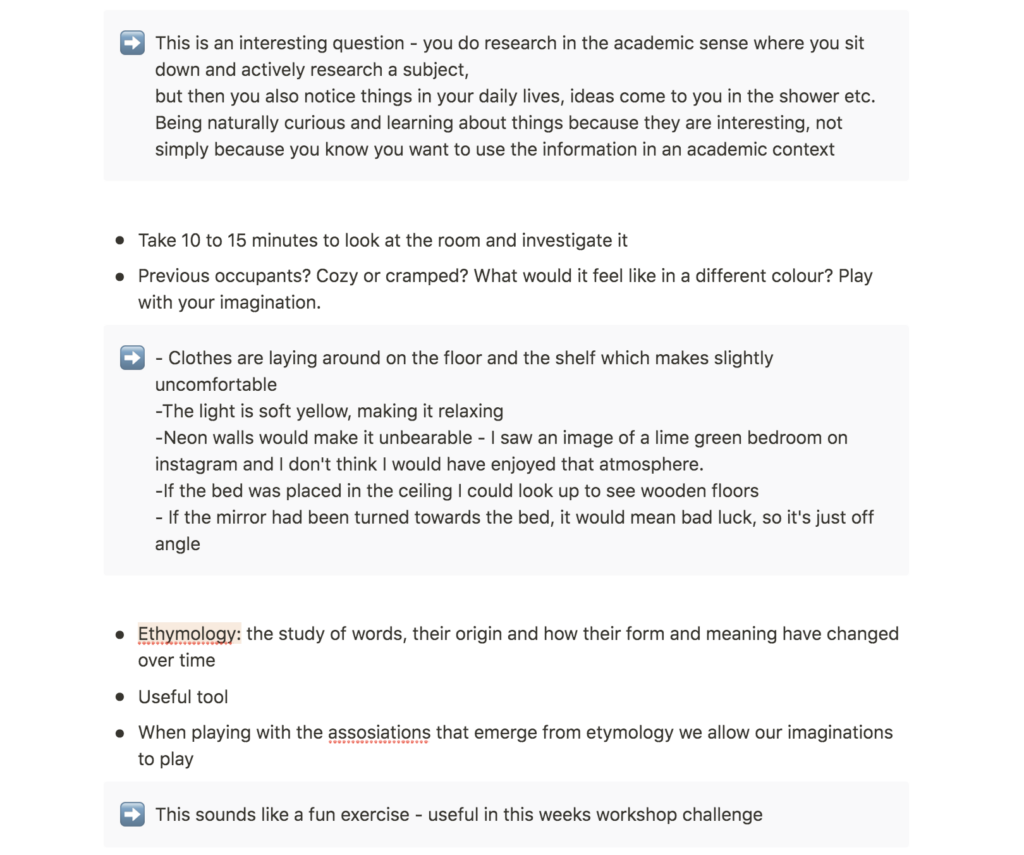
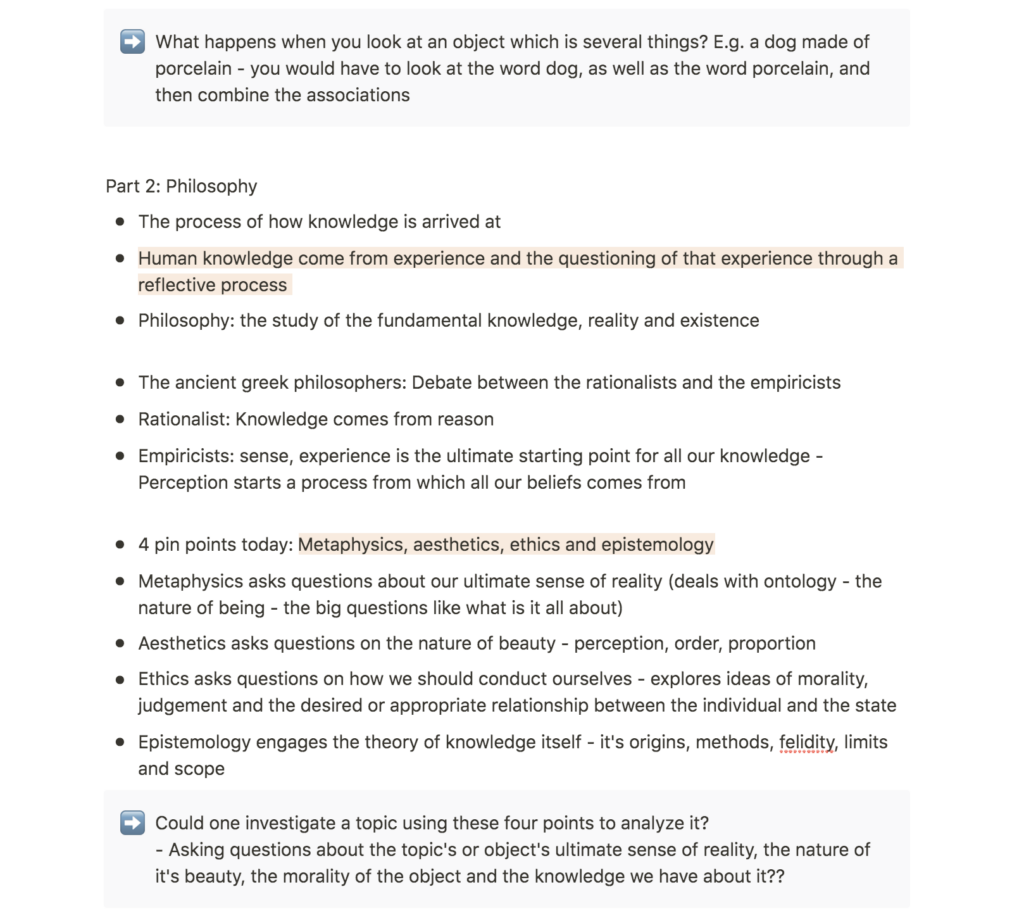
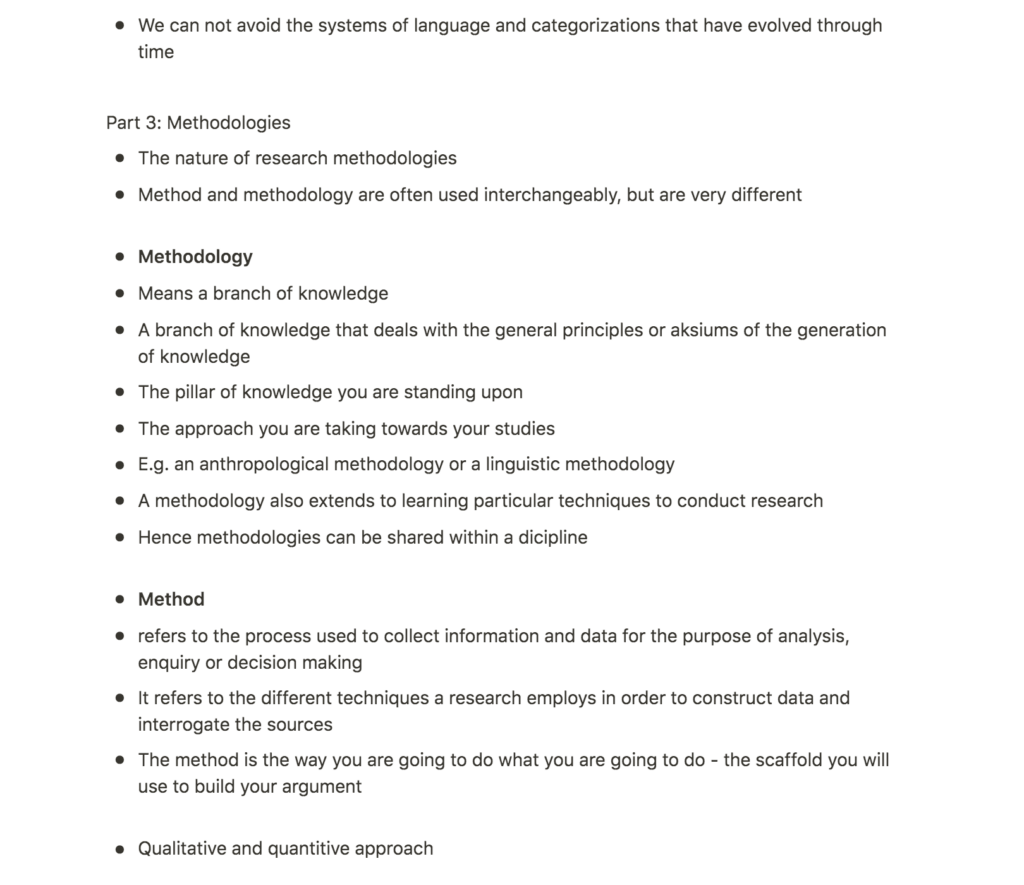
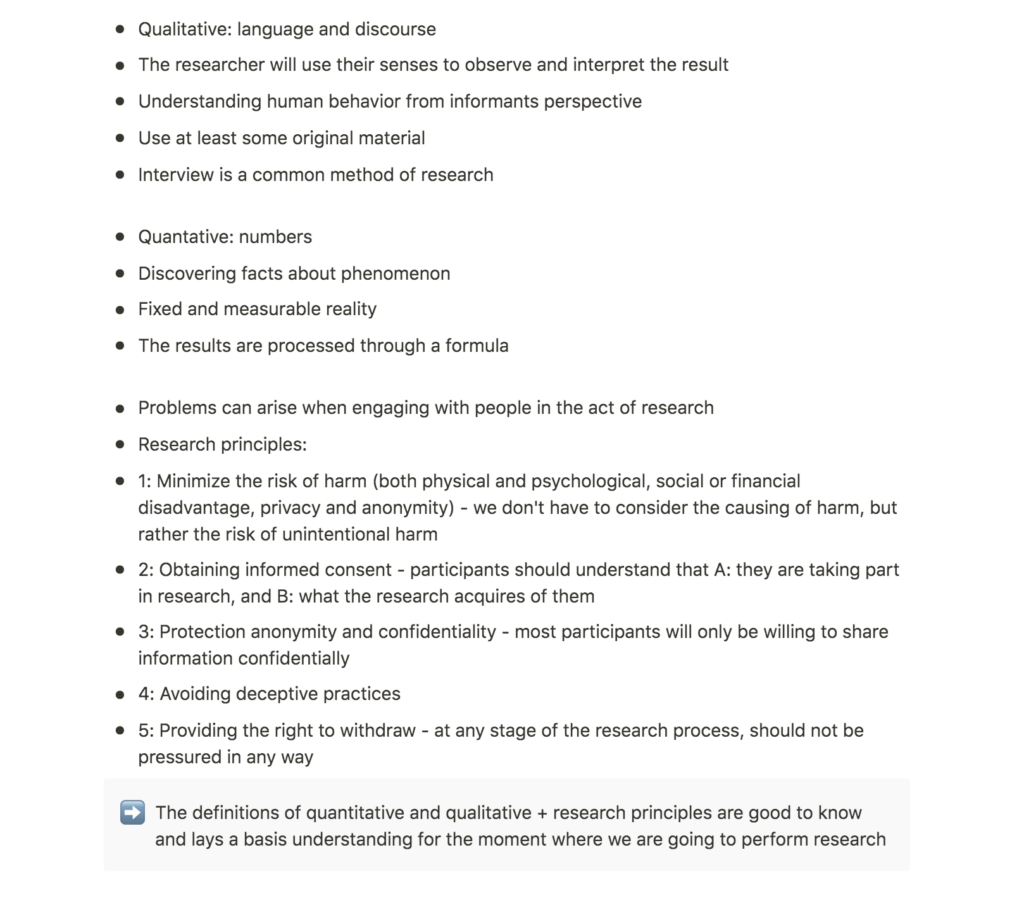
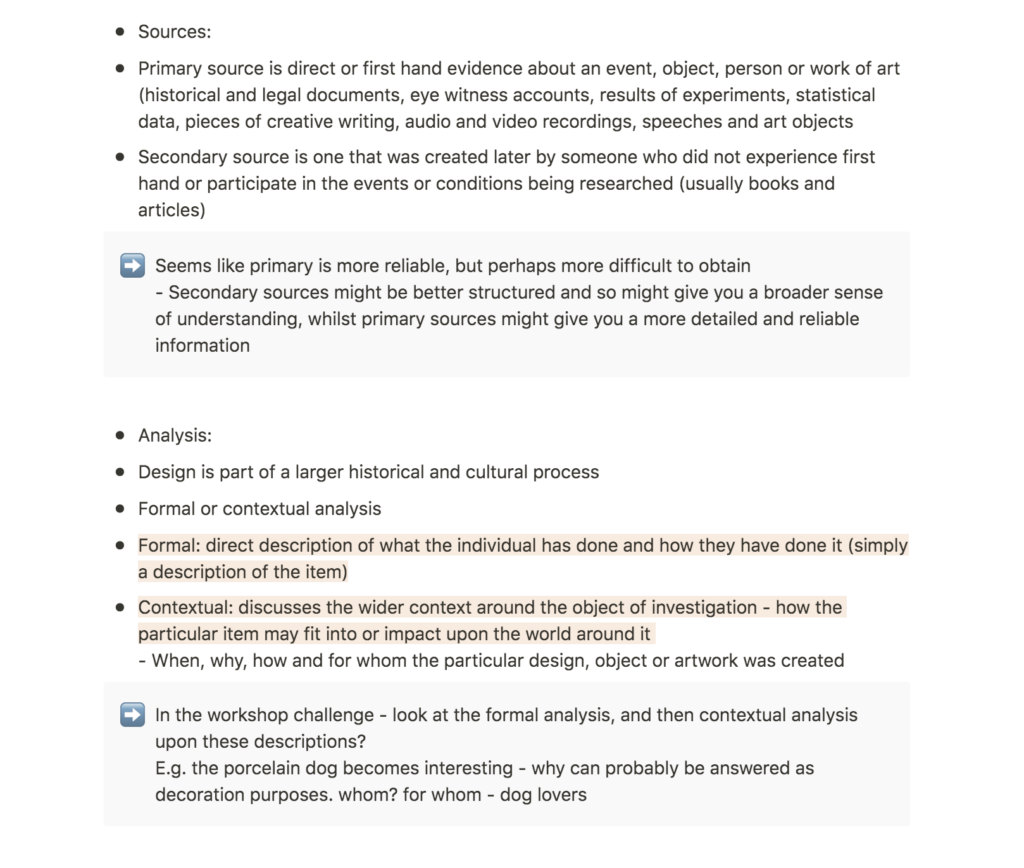
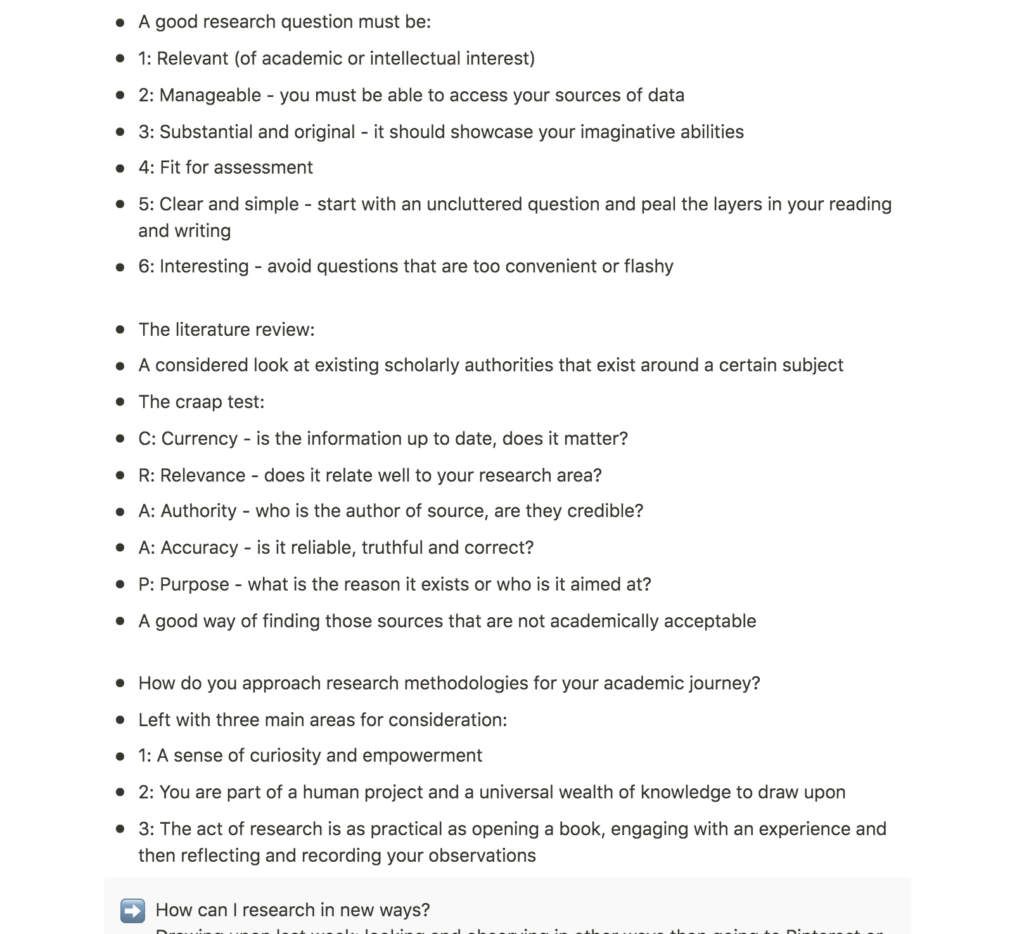
Lecture reflection
This week’s guest lecture, How do you approach research methodologies for your academic journey, by Martin Hosken, provided me with an overview of research methodologies. Although I have briefly touched upon some of the topics, like quantitative and qualitative research, research principles and literature reviews in my previous studies, it was nice to get an updated overview as I haven’t used these definitions in a while.
How can we employ humanity within our academic research?
There were also parts of Hosken’s lecture that were completely new to me, and therefor particularly useful. Hosken’s questions made me wonder how I could attempt to employ a sense of humanity within my academic research. Could sketching, blind drawing and creative writing be viewed as valid research methods within an academic context, and if so, are there contextual boundaries making these methods unfit for certain types of academic projects, like for example an essay? I think it could be interesting to investigate the usage of unconventional methods for theoretical academic projects, as I imagine that this usage might lead to new ideas and observations.
Is research an academic exercise or an activity of life?
Hosken’s question is research a science, an art or a craft, makes me think that the examples mentioned in the previous paragraph could at least be seen as valid academic research methods within the right context, especially within a visual one. Further, Hosken asks if research primarily is an academic exercise, or an activity of life (Hosken, 2020). In my work, I would have to answer both. On one hand, research becomes an academic exercise when I sit down to actively look for information of which to base my academic work upon. However, and I think this is especially valid in creative fields, I often notice information or ideas in my daily life which I later use in my academic work. Also, learning about a topic with an intention of simply learning as a result of curiosity, can often lead to knowledge, which one might end up using in academic work at a later date.
Using the pin points of philosophy as a foundation for an analysis process
In terms of more specific points mentioned by Hosken, I was intrigued by his mentioning of the four pin points in philosophy today: metaphysics, aesthetics, ethics and epistemology (Hosken, 2020). I think it could be interesting to use these points in an analysis process. I can imagine that this might result in a broad analysis which investigates a topic from different perspectives. Through asking questions about the topic’s ultimate sense of reality, the nature of it’s beauty, it’s morality and the knowledge we have about it (Hosken, 2020), I believe one could obtain a deep understanding about a topic.
Resource notes
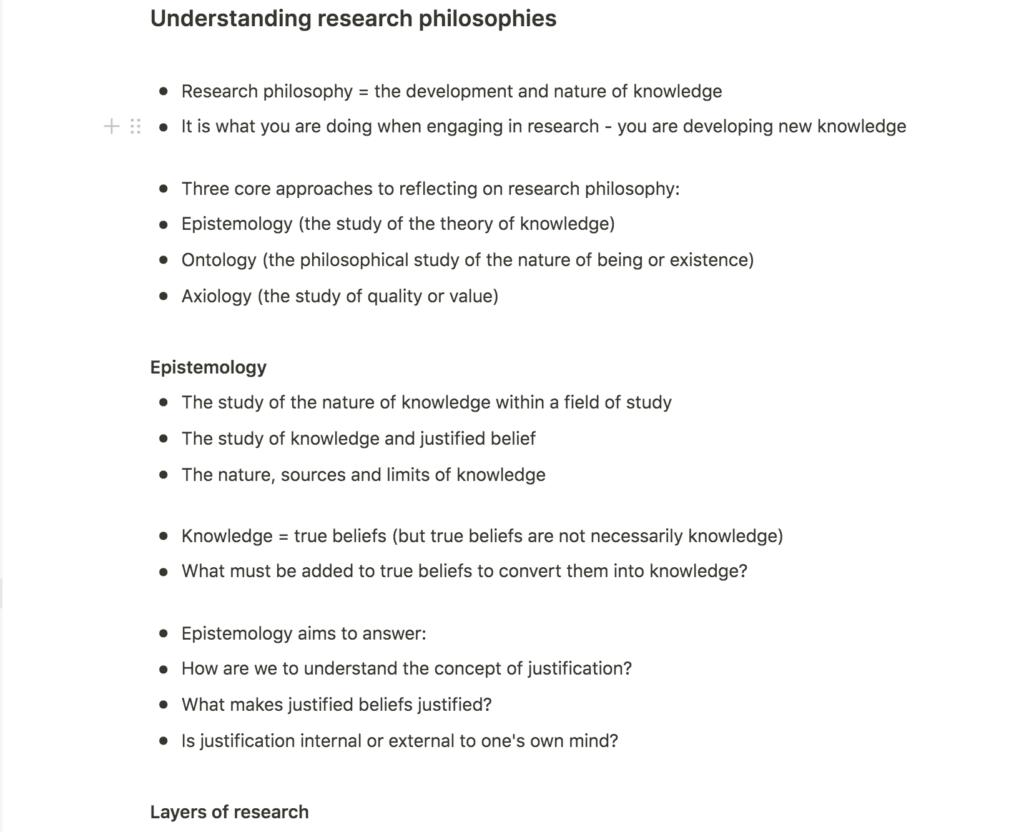
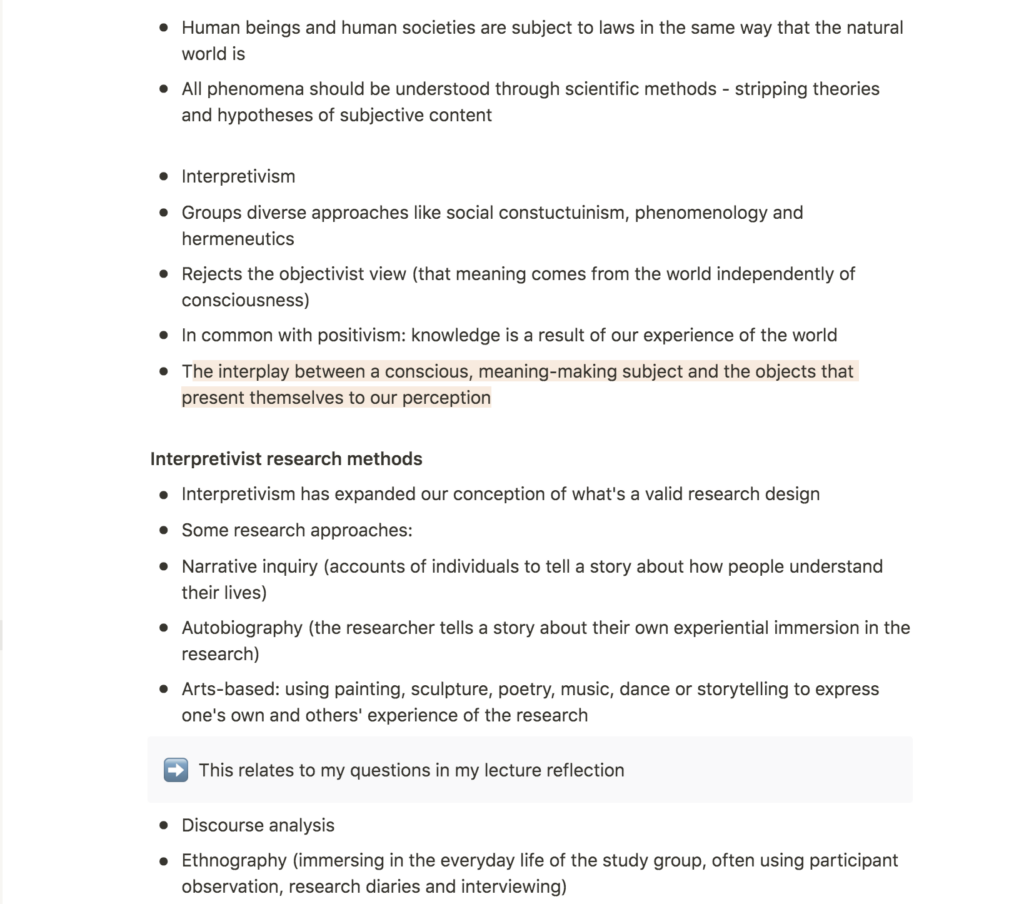
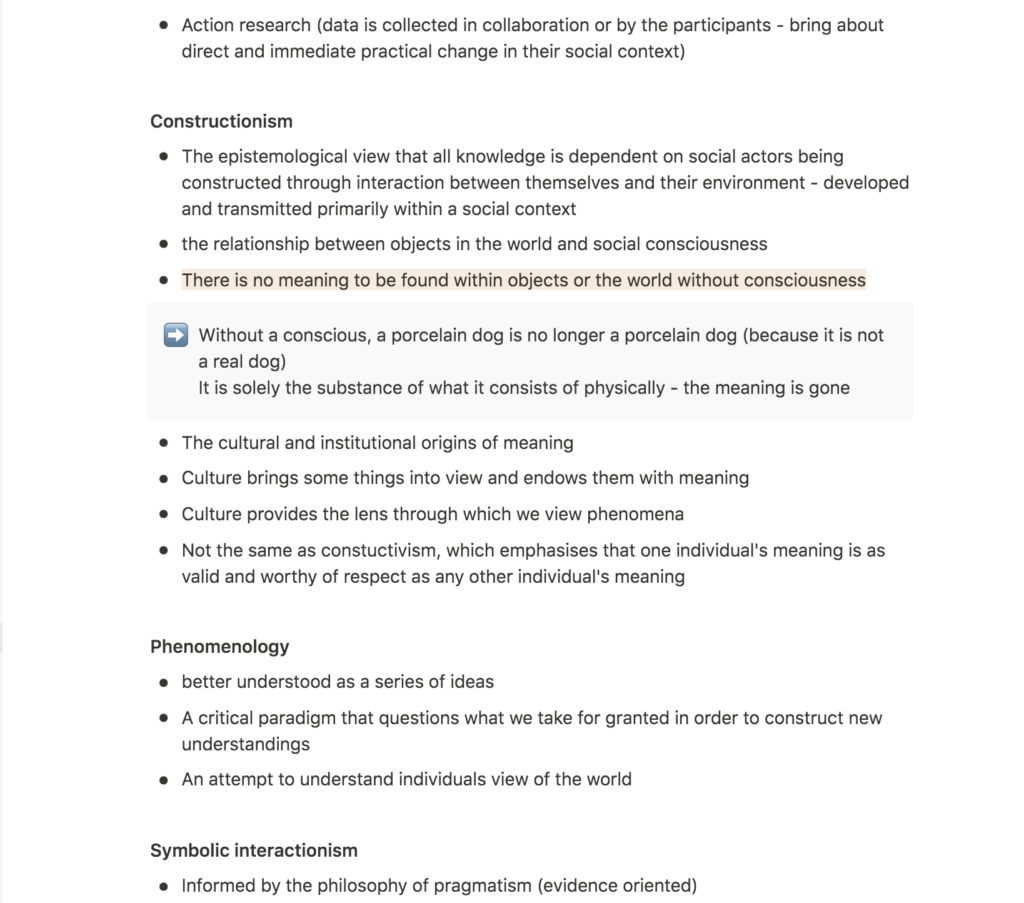
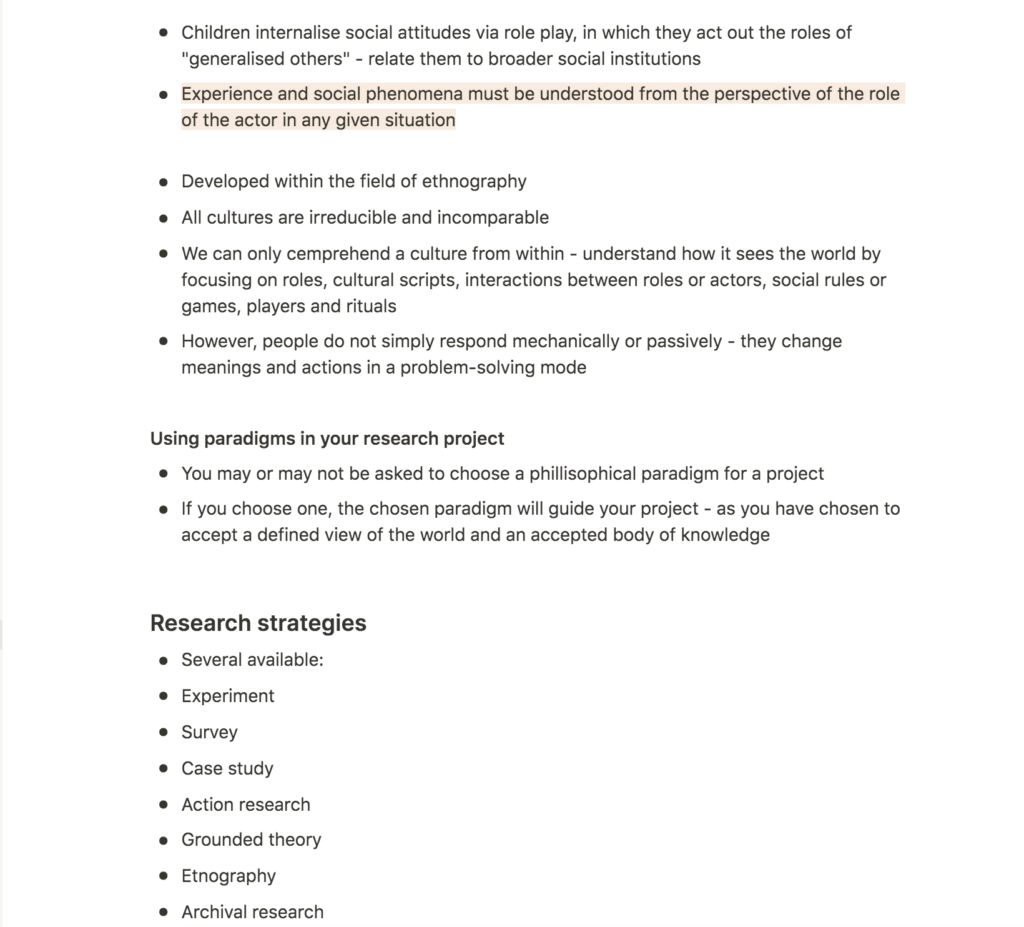
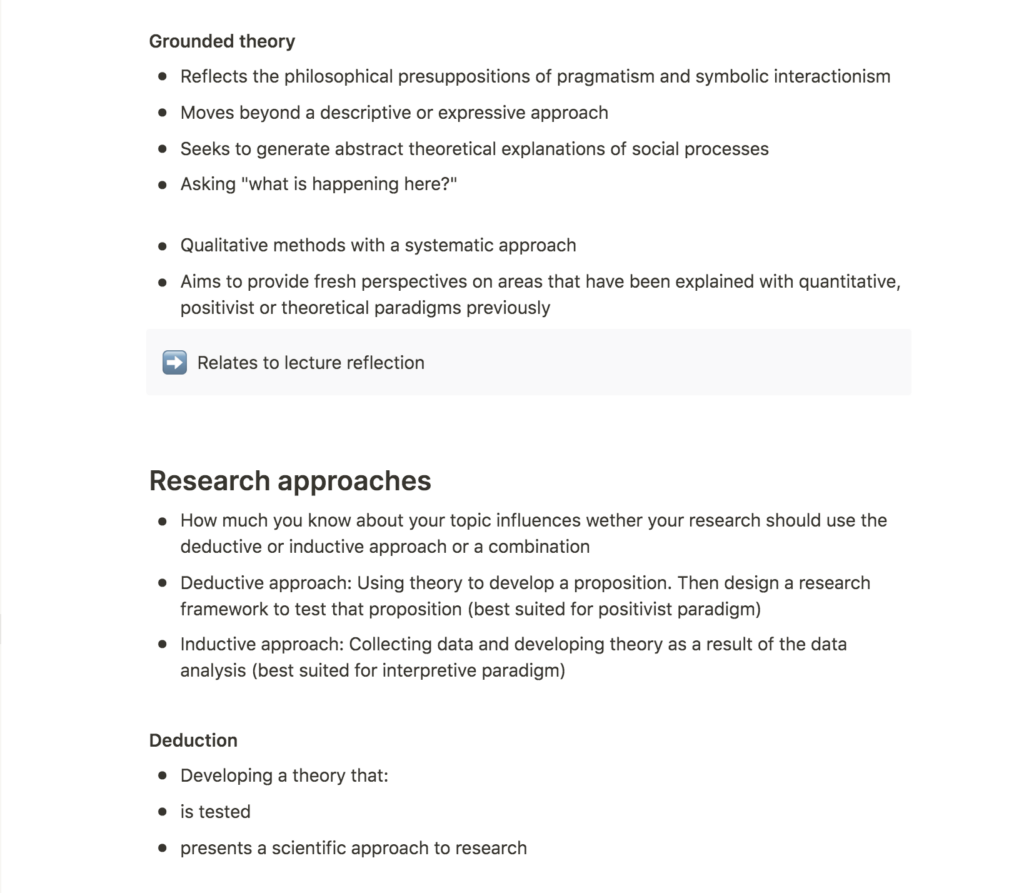
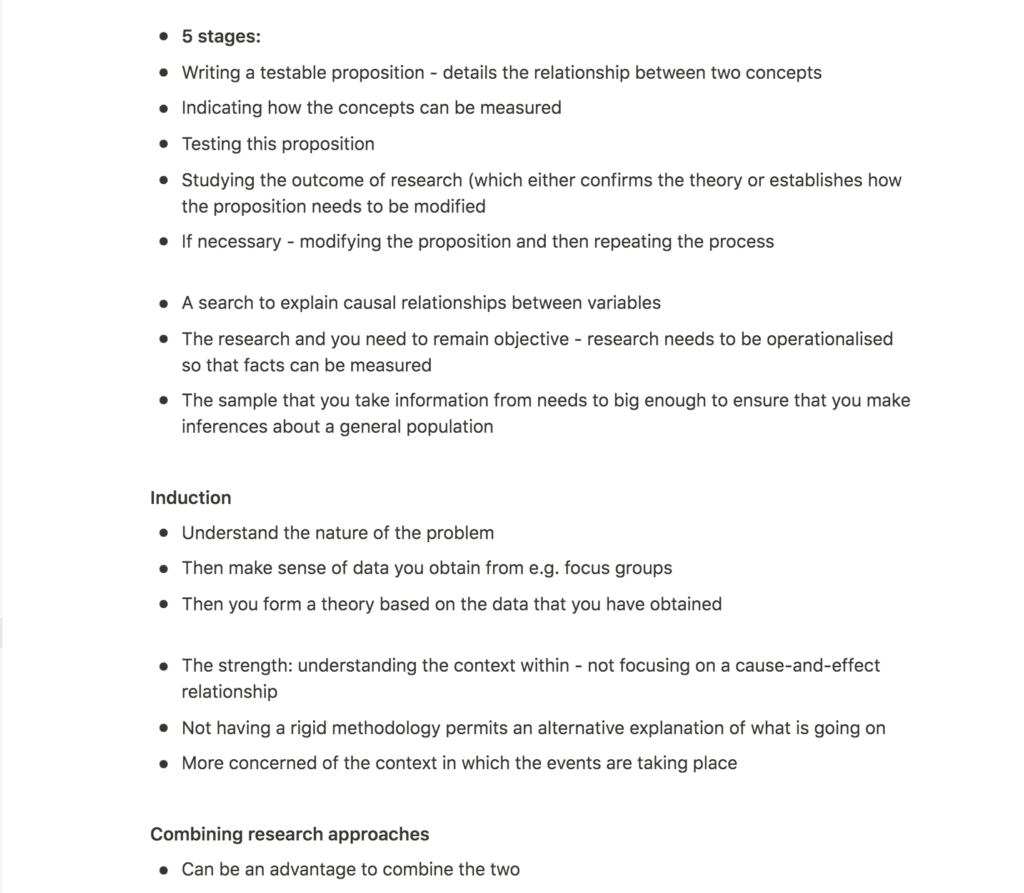
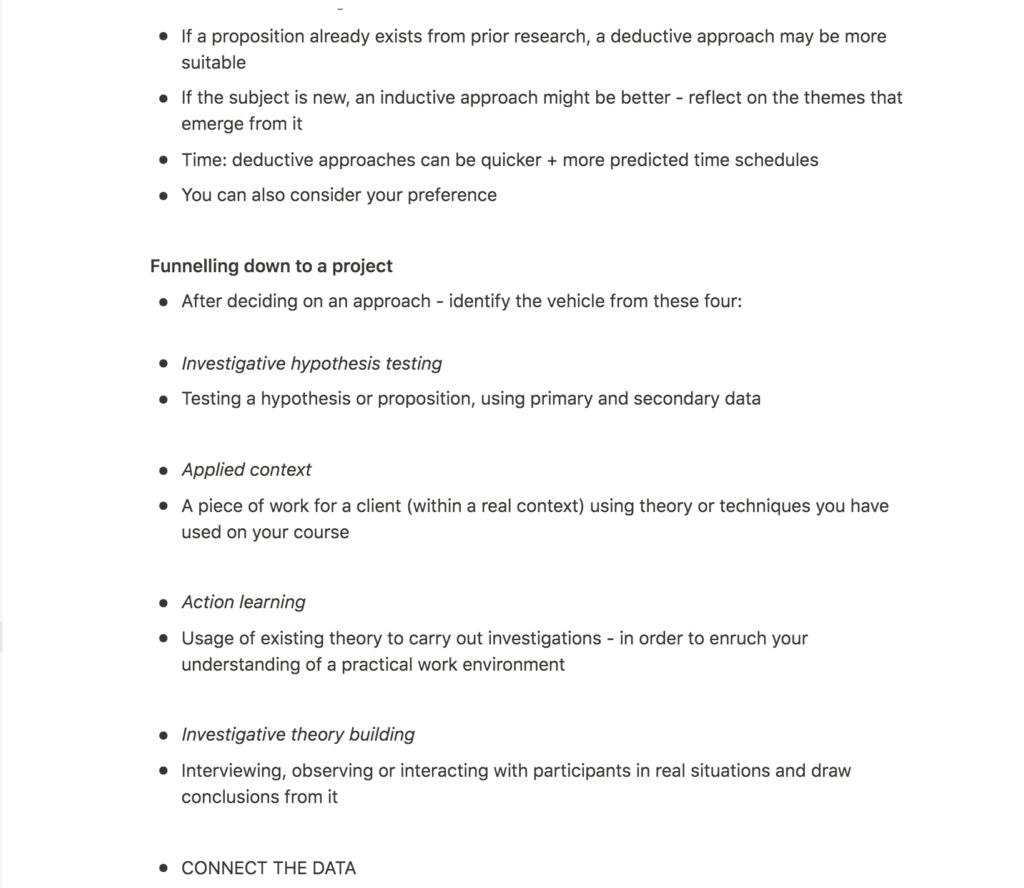
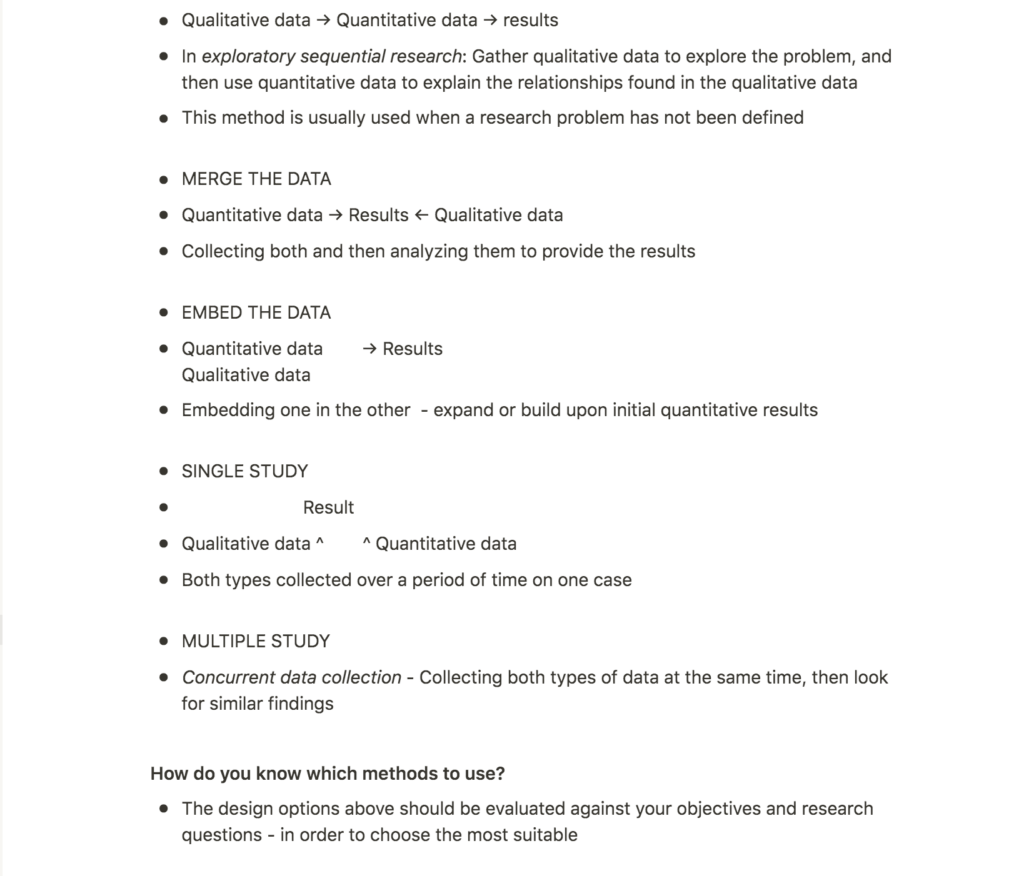
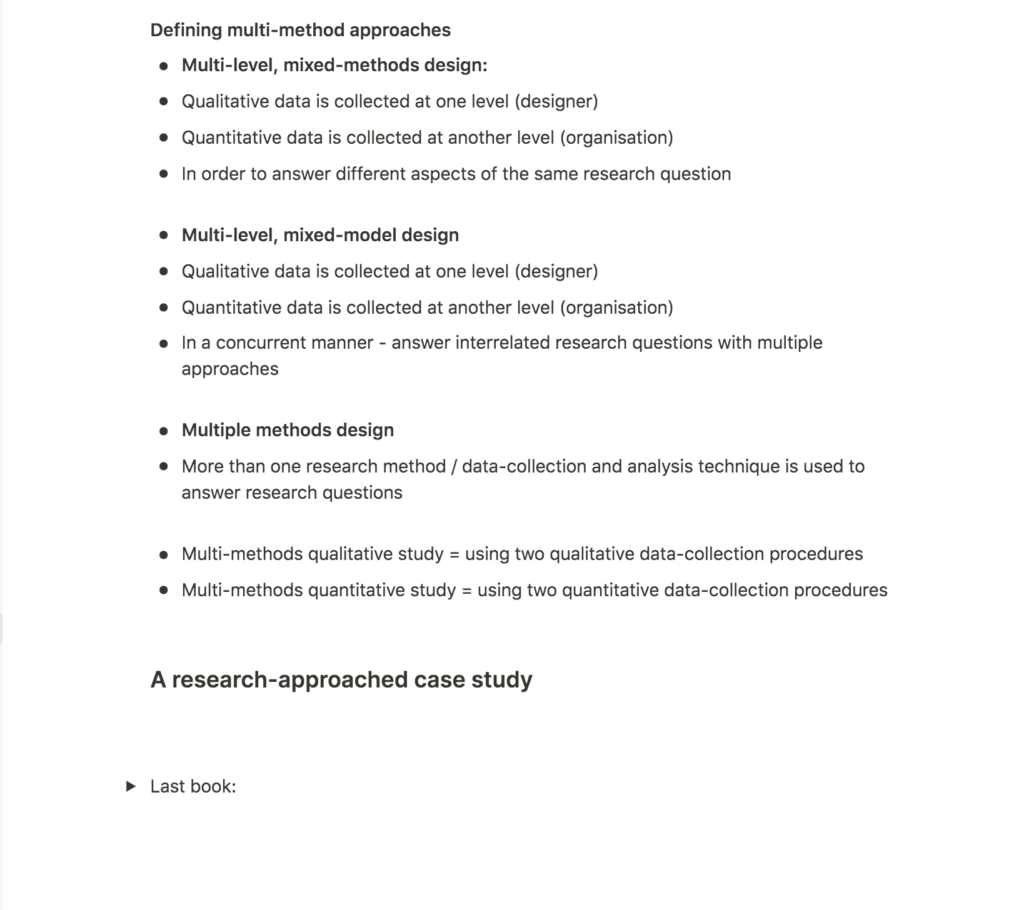
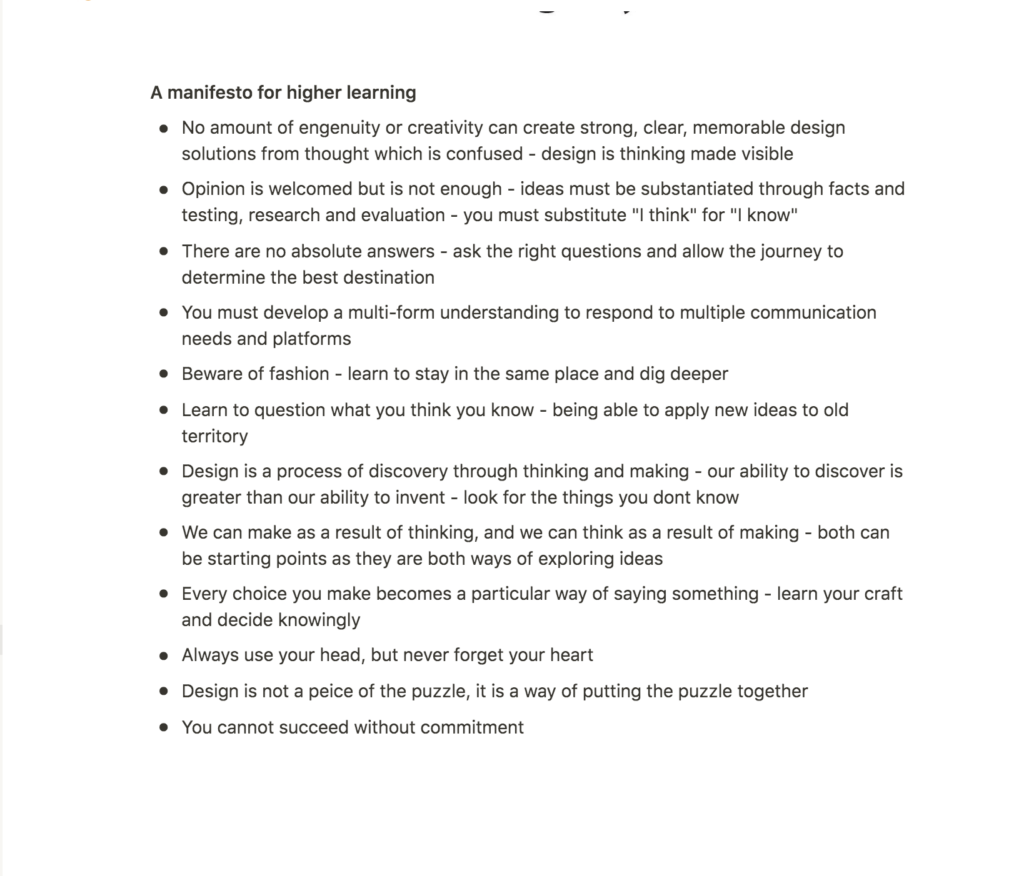
Resource reflection
Constructing a personal list of research terminology
Creative research; the theory and practice of research for the creative industries, by Hilary Collins, seemed to contain a graspable overview of research methods and terms of creative industries. As I don’t come from a graphic design background, I thought it would be useful for me to focus on retaining such an overview this week, and so I decided to focus on Collins’ book as an attempt to accomplish this. I must admit that the amount of terminologies and theories mentioned were a lot to take in, and I am surely not an expert on the philosophy of research yet. However, I think the resource was a good starting point of which to start my learning on the topic, as well as a good foundation from which to build a personal list of research terminology.
Paradigms as analysis process
Until reading about it in Collins’ book, I have not been introduced to the topic of paradigms, but I do find the concept intriguing. The fact that there are a variety of “lenses” through which one can view the world (Collins, 2010), makes me wonder wether one could utilise a group of chosen paradigms in order to look at an object or phenomenon in a variety of ways. Perhaps this type of analysis process already exists (or perhaps it is not constructive and my understanding on the subject is still to vague), but I imagine this could lead to a diverse set of findings.
Can Arts-based methods lead to fresh perspectives within an academic context?
Following upon my question from my lecture reflection, on how we might use unconventional methods when working on academic projects, one point from Collin’s book came to mind. When listing a choice of interpretivist research methods, Collins mentions the Arts-based method as a research approach (Collins, 2010). This method is based on using painting, dancing, sculpture, poetry, music and storytelling, as a way of expressing one’s own or other’s experience of research (Collins, 2010). I am intrigued as to how the usage of this method within, for example an academic essay, might result in fresh perspectives, and wether or not these perspectives would be useful or not.
Another answer to the question of how we might ensure finding new ideas and observations through research, is grounded theory, which attempts to find new perspectives on topics which has previously been looked at through quantitative methods, within positivist paradigms (Collins, 2010).
Aiming for objectivity
In addition to looking at Collin’s book, I also had a quick skim through Visual Research: An Introduction to Research Methods in Graphic Design, by Russel Bestley and Ian Noble, where I discovered A Manifesto for Higher Learning, an article originally published in The Design Observer, written by Andrew Howard (Bestley and Noble, 2005). I think as designers, we might easily fall for the temptation of “going our own way” and doing what “feels right” (I can at least admit to this). Therefor, the points mentioned in the article become important guidelines to follow, in order to create objectively good design (to the extent that that is possible). Objective design might not be a hundred percent possible, but as designers we should do our best to make sure our designs are based on valid knowledge, insight and exploration.
Workshop challenge
Design process and research methodologies
Looking back on my notes from this week’s reading, I felt as if I needed a bit more information on specific design process and methodologies. I decided to take a closer look at The Design Cycle, a model of the design process discussed and visualised in Visual Research: An Introduction to Research Methods in Graphic Design (Bestley and Noble, 2005). This process seemed graspable and so I decided to utilise the method for this week’s workshop challenge. Below you can find some notes, as well as ideas for which research methodologies I considered using.
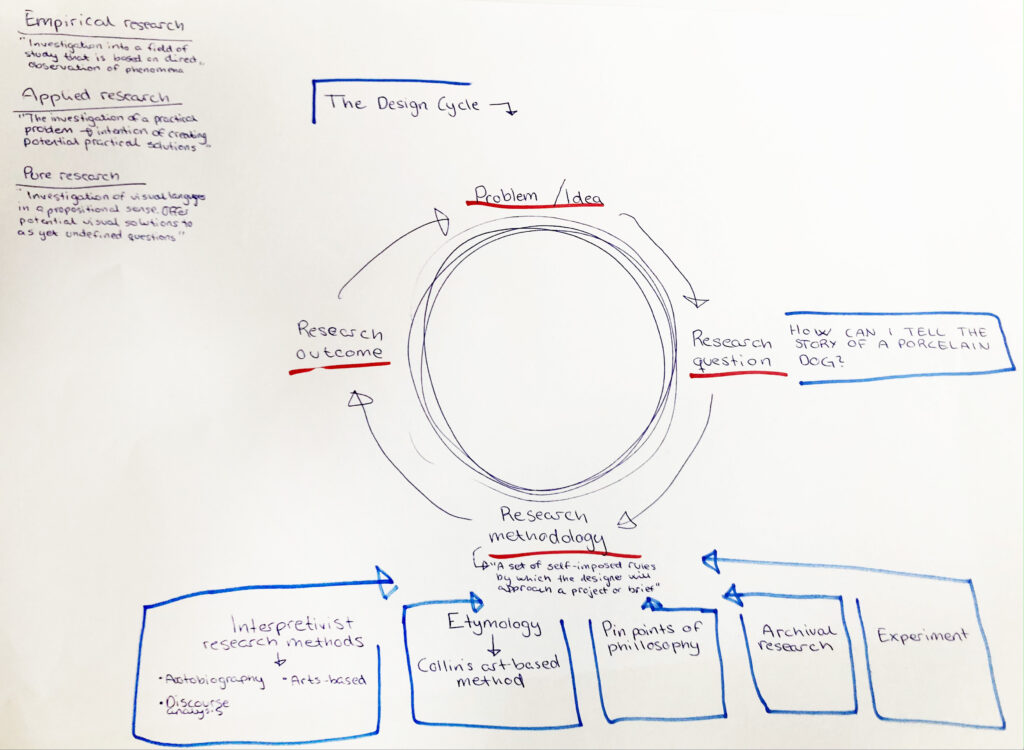
As shown in the sketch above, my research question this week is: How can I tell the story of a porcelain dog? The reason behind the choice of this particular object was the interesting aspect between object and character, and how things sometimes connects to a deeper meaning of sorts. The porcelain dog is only a dog because we are familiar with the concept of dogs due to our cultural knowledge and experiences. Had we not had this knowledge, the porcelain would simply be a piece of ceramic ware. I thought this blurred boundary of real and fake might make for interesting research findings.
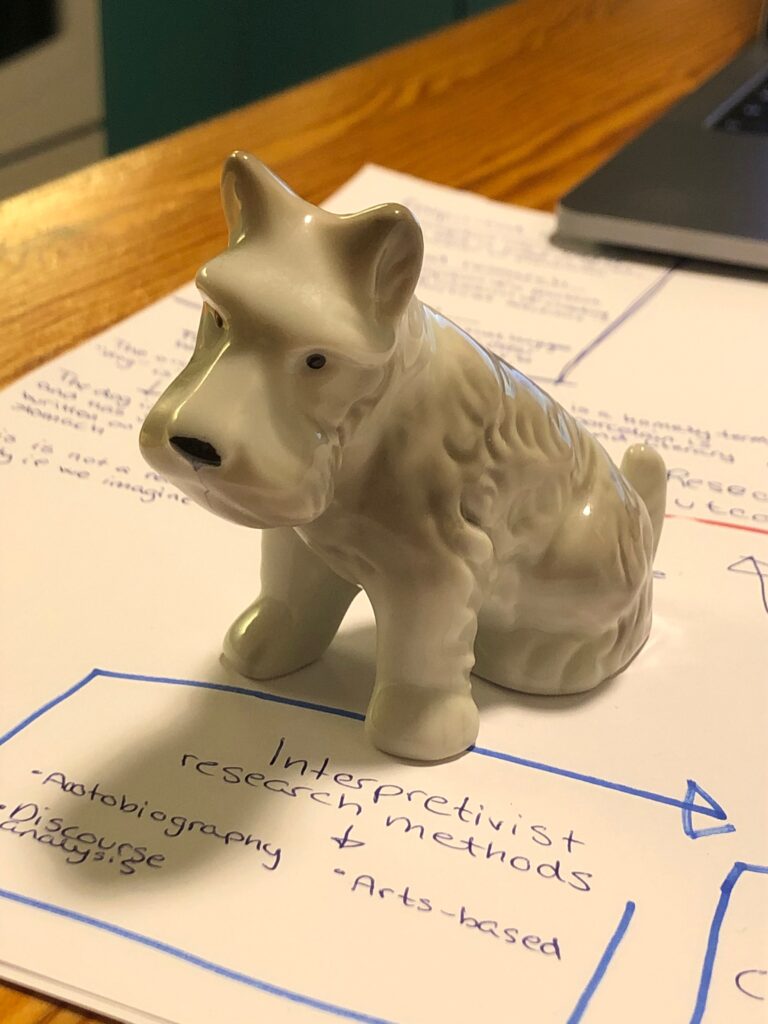
As you can see in my design process sketch, I had several ideas for my methodology. Due to the short time frame, I decided to focus on etymology (mentioned in Hosken’s lecture), as well as an analysis inspired by Hosken’s four pin points of philosophy. The latter might not be considered an established design method, but as I was intrigued to experiment, I decided to give it a go.
Etymology
About the method
Etymology is the study of words, which can be used as a method through looking at the word’s history, meaning and how the meaning has changed over time (Hosken, 2020). By looking at these factors, one might find new associations with the word, which can inform the body of research (Hosken, 2020).
Findings
Above is my findings from the etymology on the two words porcelain and dog. I was particularly intrigued by the connection between dog and the negative connotations like abusive and ugly woman. This is the opposite of what I think about when hearing the word dog. I think this method works well for my workshop challenge, as it led to a variety of points from which one might be able to construct a story.
Philosophy analysis
About the method
This method is not an established method of such (it is at least not listed as a method in the sources I have looked at this week), but rather an attempt to look at a phenomenon from a variety of viewpoints, through what I would refer to as an interpretivist analysis method. In the analysis, the researcher reflects on a phenomenon by trying to answer Hosken’s pin points of philosophy: metaphysics (asks questions about our ultimate sense of reality), aesthetics (asks questions on the nature of beauty), ethics (asks questions on how we should conduct ourselves) and epistemology (engages the theory of knowledge itself) (Hosken, 2020). The method should contain observations of both formal and contextual analysis.
Findings
As this analysis is mainly based on my own reflections and thoughts, one might criticise it for not investigating new information (coming from other sources than my own conscious). Yet, I found that the process of answering the analysis questions led to the discovery, or at least notice, of several aspects I might be keen to utilise in text. For example, the fact that the dog has JAPAN written on it’s stomach, and that the object is hollow, led to associations which might be fit for the medium of storytelling.
Complete Design Cycle
After completing my research I went on to proceed with my Design Cycle model. In the research outcome section I took notes of the most interesting points from my research. Mystery seemed to be a repeating topic – the word dog is of unknown origins. The previous history of this specific porcelain dog is also a mystery as I bought it second hand. The fact that the dog is from Japan, as well as the fact that he is hollow, made me think that if the porcelain dog had feelings, it might feel lost as he does not know where he comes from.
After analysing my research outcome, I got the idea of making a children’s story, which would revolve around an uncertainty of weather or not the dog is “real”. This also made me think about how grown ups might see the porcelain dog as a piece of decoration, whilst a child might see it as a toy. By the time I had come up with these reflections, I had a clear idea of what my story was going to be, and so I simply decided to write it.
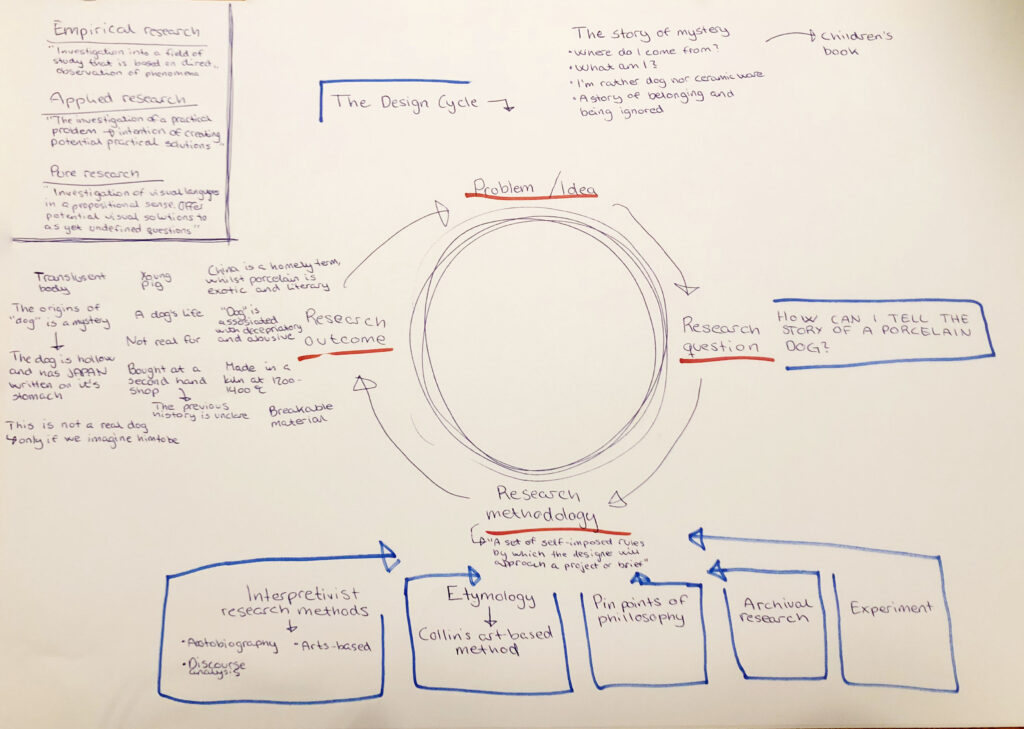
Text: Wilhelm the porcelain dog
On a completely average day in a completely average home, a lady walks through the door. She has brought home something from the market. Placing it on the living room dresser, she decides on the name Wilhelm.
Wilhelm is a creature of confusion. His tail is still and his snout is cold, not quite like his barking friend on the sofa, who gets cuddles every time he snore. Not until this average day in this average house did Wilhelm notice the hollowness inside him, nor how his translucent body compares to theirs.
On Wilhelm’s stomach there is a symbol or code of some kind:
“JAPAN”
He wonders what it means.
There’s no wandering about or wagging the tail for Wilhelm, but one day, a week or so after the average day, something quite the opposite of average takes place. As always, Wilhelm is sat at the dresser, concerned with the mysteries of why and how, when some fingers appear from below. They’re twisting and turning, until they finally get a grip around Wilhelm’s cold and stiff fur.
Out of nowhere Wilhelm can walk and run and bark, even talk like humans do. He’s part of a universe more grand than them all, filled with soldiers, bouncing balls and slime. And it doesn’t stop there. Soon he is outside, running the moist fields of the abundant surroundings in the garden. – Is this JAPAN? wonders Wilhelm.
Then later, he’s back on the dresser, with a sticky sensation in his neck. – We were just playing, said the owner of the twisting fingers, but the lady is strict and says: – You see, Wilhelm’s not a dog, no, not really. He’s decoration and on the shelf, he will be. When you grow up and get an apartment, you’ll have Wilhelms on your shelfs, wait and see.
Visual concepts and references
Tone Jansson
As I decided to write a children’s story, it was natural for me to look to my favourite children’s books illustrator, Tove Jansson, who created the Moomins. Her original black and white drawings remind me of the Scandinavian winter, which is can often be dark and melancholic. The darkness of Jansson’s Moomin illustrations was an element I wanted to incorporate in my illustrations as a way of expressing the melancholic essence of the story.
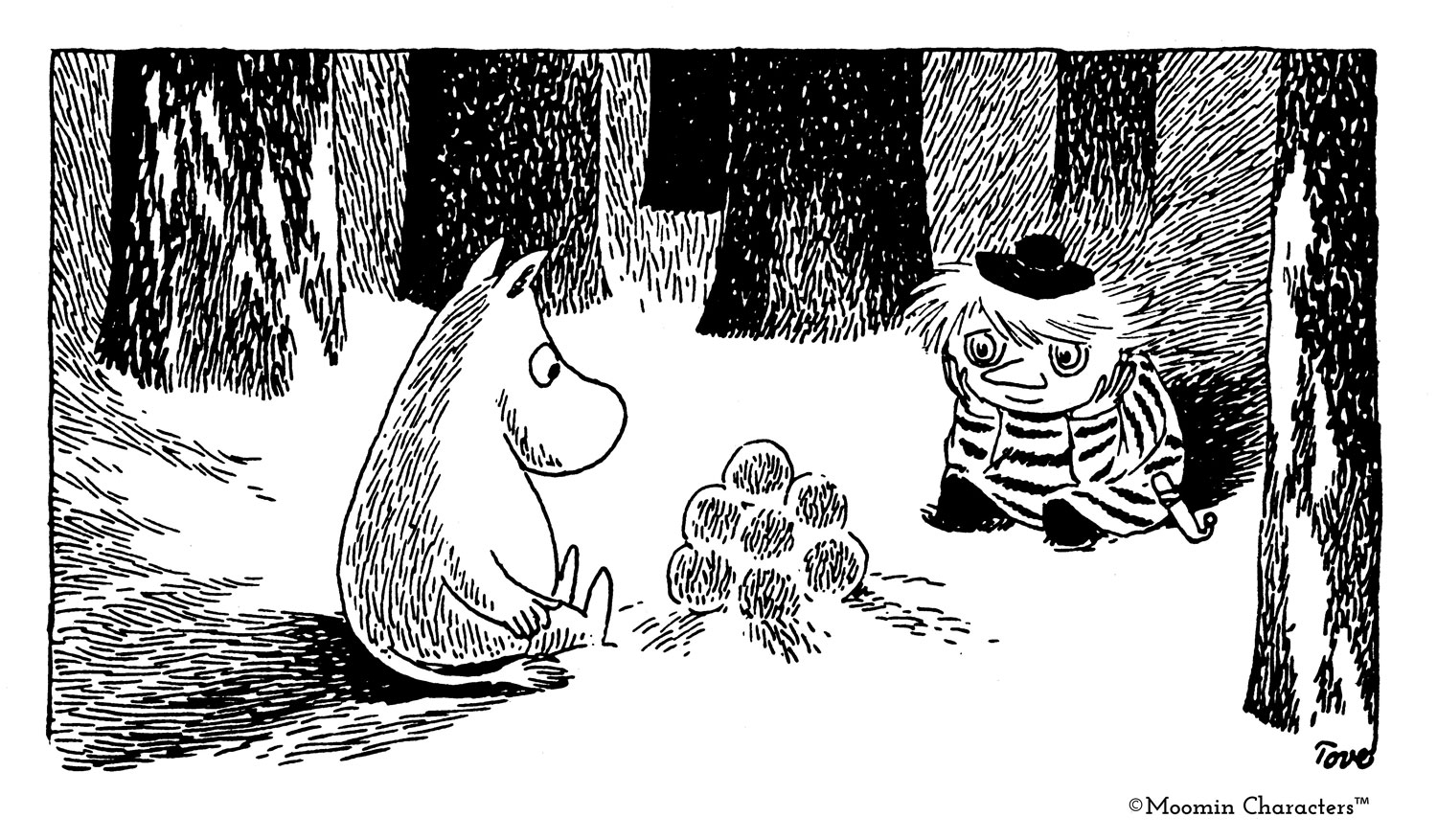
Marcus Oakley
In last week’s blog post I looked at Marcus Oakley’s illustrations of houses and outside locations. As I quite like his illustration style, I decided to look into his work further this week. I am inspired by his ability to pair sharp geometric shapes with organic strokes, which I think results in a minimal, yet domestic aesthetic. This notion of the domestic was an inspiring element that I wanted to refer to in my visual piece, as the story is about a decoration piece, which is a very domestic object.

Illustration techniques
I’m not an experienced illustrator, but I would like to get better. In order to develop my technique, I decided to do some experiments using various techniques (some were not so successful), in order to find a suitable style for the editorial piece. If I had more time I would have spent more time on this process as I didn’t find a technique I was completely happy with. As the weeks pass I will continue to work on my illustration technique skill set.
I did find the crayon strokes (bottom right in the image gallery bellow) to resonate with the aspect of a childlike viewpoint, which my story also explores. I therefor decided to go with this technique.
Final editorial piece
Melancholic visuals
For my final editorial piece I’ve attempted to illustrate the melancholic and lost feeling that is going on inside Wilhelm. In order to achieve this, I’ve incorporated a lot of blacks and illustrated his face to look unhappy. Through a happy accident I discovered that black strokes with a white background on top of a full page black background, worked well for melancholic visualisations.
Conveying the Japanese origins
As Wilhelm was created in Japan, I wanted to incorporate some Japanese elements in the illustration. I’ve done this through the usage of a few red details and of course by writing “Who” in Japanese, illustrating Wilhelm’s thoughts. I have also chosen a typeface which reminds me of the Japanese writing system, in terms of it’s stiffness and sharp lines.
Further work
There is a lot I would have liked to work on further for this week’s project. As mentioned previously, I would have liked to experiment further with different illustration techniques, in order to create something more detailed and in line with the story. As I’m not a great drawer, there were a lot of ideas I didn’t manage to utilise in my drawings within the set time frame, and so I think the illustrations could have become more witty and conceptual.
It also would have been good to create spreads where the typography and illustrations work together as they currently seem like two separate elements. This might have been possible by creating more detailed drawings, and through taking advantage of the format of the book, so that the illustrations fit the pages better.
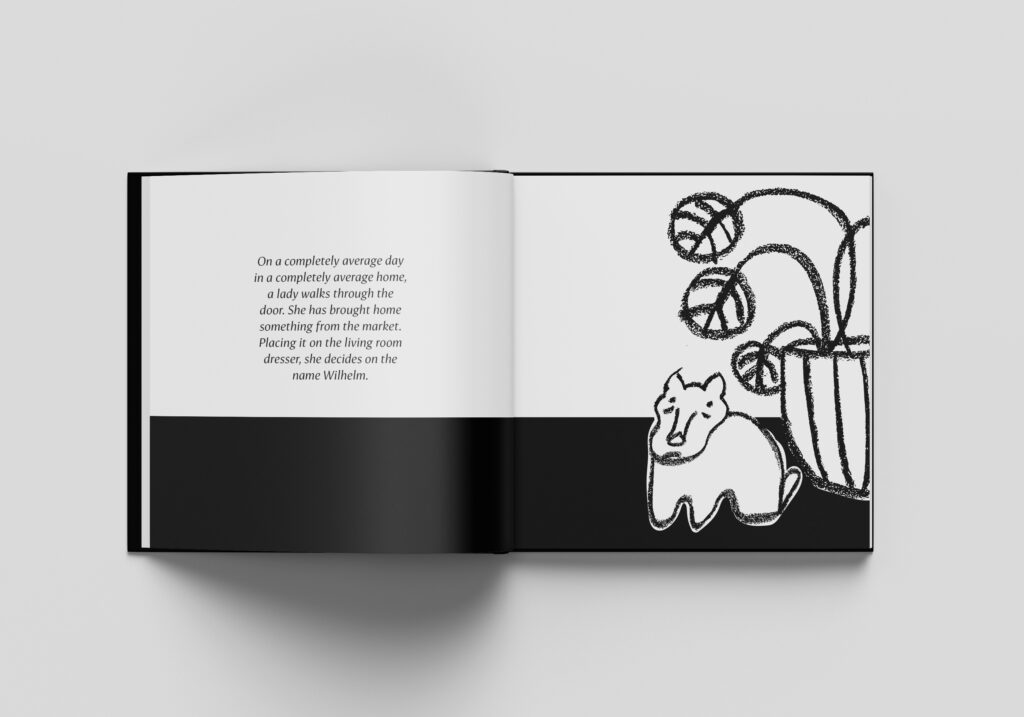
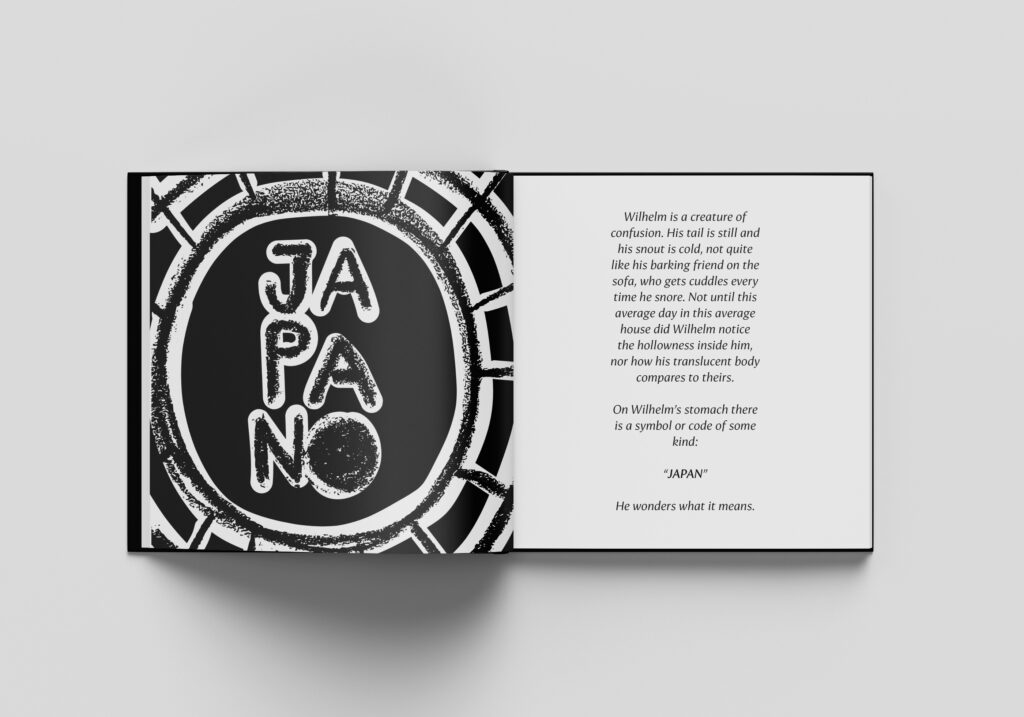
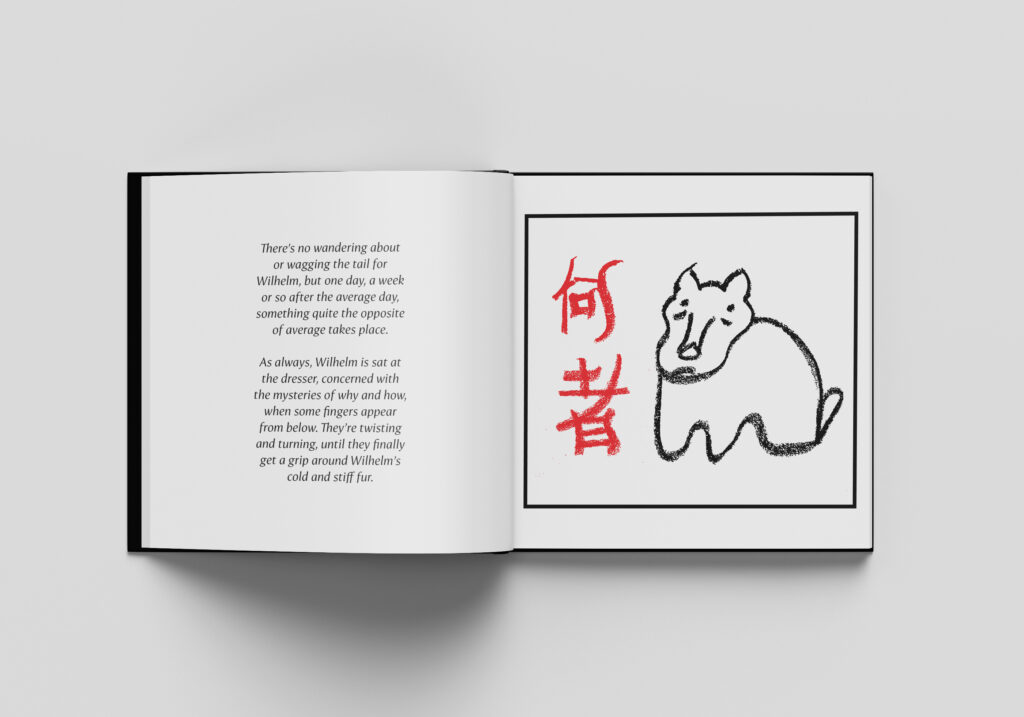
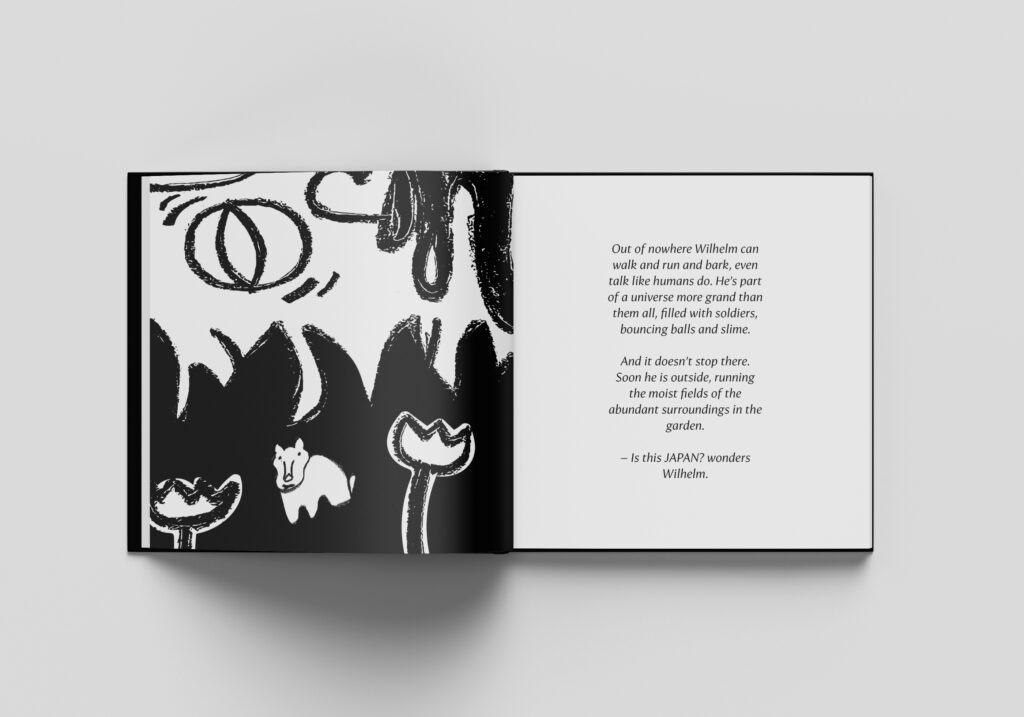

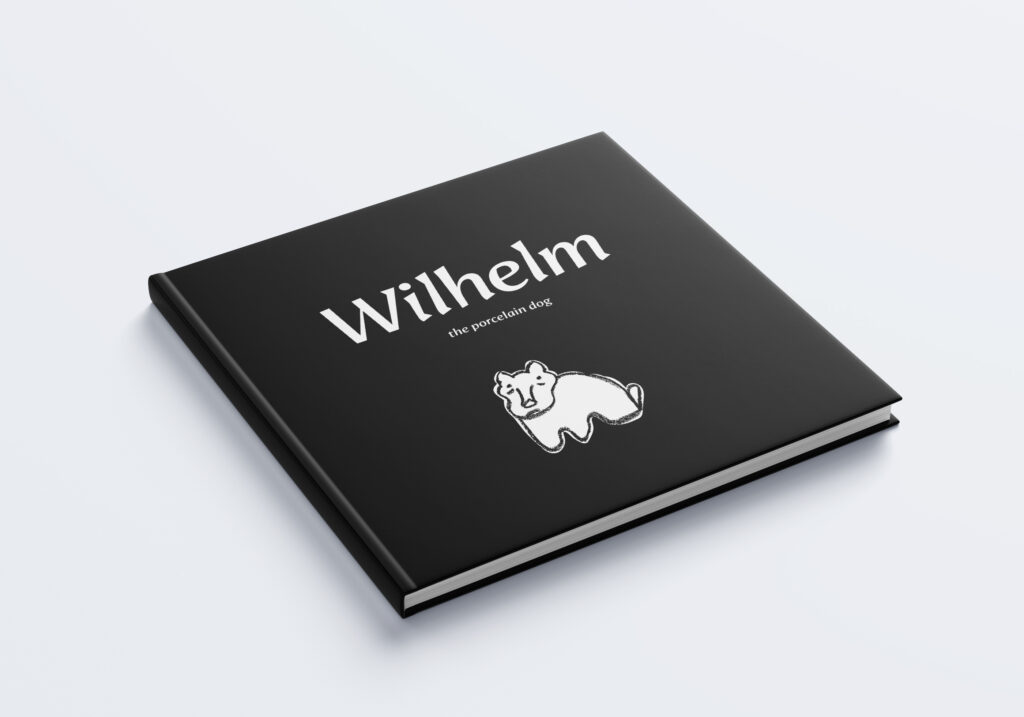
In conclusion
This week has given me a better understanding of graphic design methodologies and methods, which has been very useful as this is quite an unfamiliar topic to me. However, the fact that this is unfamiliar also means I ended up spending a lot of time trying to understand the reading material, which meant less time to experiment and visualise my workshop challenge. Thus, I look back at this week, wishing I had been able to create something more meaningful and finished. I also would have liked to do some further research this week, perhaps on how one might use art-based research methods in design.
I still feel slightly unfamiliar with the theory behind graphic design methodologies, but it has been interesting to obtain a slightly deeper understanding. My chosen methods for the workshop challenge were very useful as ways of coming up with unique stories and focus points, and I will take these methods with me into my further practice. If I had more time, I would have tried to incorporate design methods for my visual piece, and not just for my written text. This might have led to a piece of visual work which incorporated the concept of my text in a more detailed and witty way.
I leave this week reminded of the importance of theory. I can be prone to solely focusing on visual learning aspects, which might sometimes lead to not understanding the theory in detail. Thus, it was probably for the better that this week became one of reading and writing, and not just visual experimentation. I leave this week with the intention of continuing my learning on design methodologies, as this is a type of knowledge I believe we must obtain as designers, in order to create objectively good design.
RESOURCES:
Bestley, R. and Noble, I. (2005) Visual Research: An Introduction to Research Methods in Graphic Design. New York: Fairchild Books.
Collins, H. (2010) Creative Research; The Theory & Practice of Research for the Creative Industries. New York: AVA Academia.
Harper, D. (Ca. 2000-2020b) ‘Porcelain (n.)’, Online Etymology Dictionary. Available at: https://www.etymonline.com/word/porcelain#etymonline_v_18472 (Accessed: 2 November 2020).
Harper, D. (Ca. 2000-2020a) ‘Dog (n.)’, Online Etymology Dictionary. Available at: https://www.etymonline.com/word/dog (Accessed: 2 November 2020).
Hosken, M. (2020) ‘How do you approach research methodologies for your academic journey?’, 30 October.
LIST OF FIGURES:
Figure 1. Tove JANSSON. 1958. Moominland Midwinter. Moomin [online]. Available at: https://www.moomin.com/en/blog/going-over-to-the-ghost-side-queer-themes-in-tove-janssons-life-and-work-part-3/#3e027858
Figure 2. Joost STOKHOF and Marcus OAKLEY. 2020. A Couple of Days in Quarantine. It’s Nice That [online]. Available at: https://www.itsnicethat.com/articles/marcus-oakley-joost-stokhof-a-couple-days-of-quarantine-illustration-publication-090720
Figure 3: Ingrid REIGSTAD. 2020. Dog illustration experiments. Private collection: Ingrid Reigstad.
Figure 4: Ingrid REIGSTAD. 2020. Wilhelm the porcelain dog. Private collection: Ingrid Reigstad.
